Animal Behavior and Visual Perception:
How Does Sea Turtle Vision Differ from Ours?
Mike Salmon, Ph.D.
Research Professor, Department of Biological Sciences
Florida Atlantic University
Research Professor, Department of Biological Sciences
Florida Atlantic University

I entered graduate school in zoology without really knowing what area in that enormous field was of greatest interest. I did know that spending time around marine habitats, head on view of a juvenile green turtle be they marshes,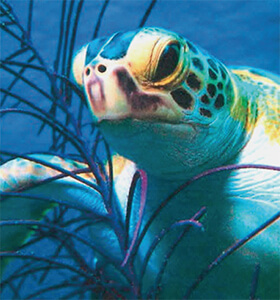 bays or the open ocean, was where I was happiest, especially when observing the amazing activities of their inhabitants. All that uncertainty disappeared two weeks after I enrolled in an Animal Behavior class taught by the professor who ultimately guided my studies toward an advanced degree. His class was an introduction to the entire field and covered a wide range of topics in two general areas: (i) what we knew (at the time) about what animals did and why they did it, and (ii) how to design proper experiments to find out more. I was soon totally “hooked”!
bays or the open ocean, was where I was happiest, especially when observing the amazing activities of their inhabitants. All that uncertainty disappeared two weeks after I enrolled in an Animal Behavior class taught by the professor who ultimately guided my studies toward an advanced degree. His class was an introduction to the entire field and covered a wide range of topics in two general areas: (i) what we knew (at the time) about what animals did and why they did it, and (ii) how to design proper experiments to find out more. I was soon totally “hooked”!

Figure 1. A head-on view of a juvenile
green turtle, showing its large eyes.
green turtle, showing its large eyes.
I was particularly interested in studies showing that animals differed in how they perceived their world. Those differences were caused by the unique properties of their sense organs (eyes, ears, touch, smell, etc.) used to inform them about their environment. Those aspects sometimes included information that we can’t detect, such as the earth’s magnetic field or high-frequency “ultrasound”. Collectively, those discoveries led to the realization that how we view the world is unique to us, but not a “better” version than one possessed by another species. The common denominator is that each complement of sense organs provides a perceptual “window” into the external world. That window is modified through evolution to detect what each species needs to know. A proper understanding of that perceptual world requires knowing not only where each species lives (on land or under water), but also what it needs to know to survive in a hostile world.
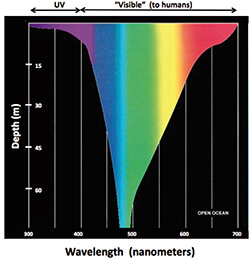
Figure 3. The transmission of light wavelengths through clear seawater varies with br depth. Near the surface , most of the light wavelengths present in air are also found under water. But, with an increase in depth, wavelengths shorter or longer than 475 nm rapidly disappear.
Sensitivity measurements (1) have confirmed these relationships (Figure 4). All species of marine turtles are sensitive to most of the light present near the ocean surface.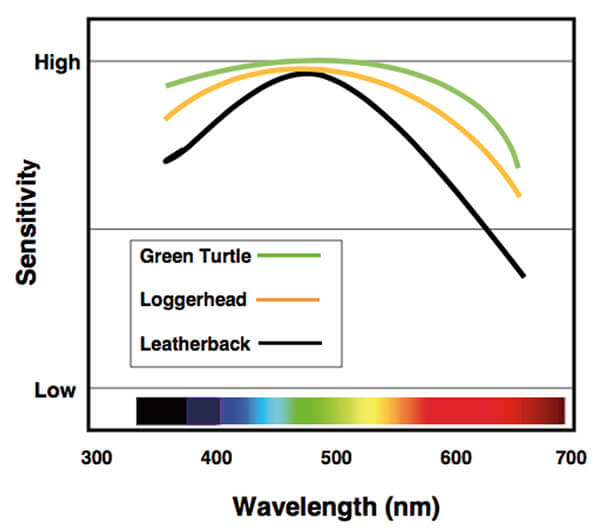
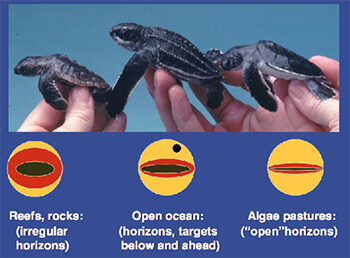

Figure 4. Sensitivity to the spectrum of light wavelengths varies among species of marine turtles and is correlated to the depth where they spend the most time. Green turtles that feed in shallow water are most uniformly sensitive to the wavelengths present there. Leatherbacks feed in deep water and are most sensitive to bluish light near 475 nm that penetrates deepest. Such “tuned” sensitivity helps them see objects at those locations. Loggerheads show light sensitivities roughly intermediate between those two patterns

Figure 6. Retinal anatomy of hatchling loggerhead (left),
leatherback (middle) and green turtle (right). Yellow, red
and black regions show low, medium, and high
concentrations of visual analyzers, respectively, at those locations.
leatherback (middle) and green turtle (right). Yellow, red
and black regions show low, medium, and high
concentrations of visual analyzers, respectively, at those locations.
On the other hand, there is a relatively simple and easily understood relationship between the concentration of these analyzers on the retinal surface and the visual ecology of animals living in different places. Animals found in open areas with a clear view of the horizon are most interested in visual events that take place on that horizon (for example, the approach of a predator). For that reason, they concentrate their retinal analyzers in a narrow, horizontal “visual streak” that parallels that location (Figure 5). Visual streaks are less prominent among animals that must maneuver through or around obstacles, such as trees in a forest or reefs under water. On the other hand, predators that detect discrete targets often concentrate their retinal analyzers in circular spots called “areas”. These areas are appropriately placed in the retina to register the location of those targets in space.
One of our students (2) took on the very laborious task of identifying the concentration of those retinal analyzers in hatchling green turtles, loggerheads and leatherbacks. (These were all turtles that had recently died inside the nest so none were sacrificed.) The results were quite interesting! Green turtles and loggerheads had visual streaks but those streaks were especially narrow in green turtles (Figure 6) that feed in open seagrass meadows (Figure 5). The retinas of leatherback hatchlings contained both a visual streak and an area, with the latter located in the upper half of the retina toward the rear of its concavity. That area would focus on targets located in the opposite direction, that is, ahead and below the turtle. Leatherbacks sometimes hunt for jellyfish while swimming near the surface. When they see one beneath and ahead of them, they dive down to consume it (Figure 7). That’s why our student called the leatherback area a “jellyfish detector”.
Do Sea Turtles have Color Vision?
Color vision is characteristic of many, but not all, day-active animals. It plays an important role in recognizing mates, in finding suitable food, and in detecting enemies. Because color vision requires a lot of additional neural machinery, it doesn’t always evolve because there is another, simpler alternative.
Objects can also be distinguished on the basis of the intensity of light reflected from their surface; objects then appear white, black, or show different shades of grey between those extremes (think black & white movies!). Thus, to demonstrate color vision requires experiments that eliminate the possibility that objects might be distinguished on the basis of light intensity cues. If that’s done and the objects are still distinguished, then the only alternative is that color vision is used.
With these generalizations in mind, let’s explore how sea turtles use one sense organ, their eyes (Figures 1 and 2), to better understand why their visual world differs from ours. I’m proud to say that much of this information has been recently provided by biology graduate students at Florida Atlantic University. Their names and thesis titles are cited at the end of this article.
Oceanic Light Transmission and Spectral Sensitivity
Light consists of a range of wavelengths transmitted from the sun to the earth’s atmosphere that penetrate the sea as downwelling energies. The eyes of oceanic animals like marine turtles function in an environment where the available light not only fluctuates between night and day, but also with depth (Figure 3). Blue light at ~ 475 nm (nanometers, or 10-9 m) is transmitted best through clear seawater while with depth, light wavelengths shorter or longer gradually disappear. Sea turtles usually search for food visually during the daylight hours, but different species most commonly feed at different depths. Green turtles, for example, are herbivores that feed on algae and seagrasses.
Those plants must live in shallow water where they are exposed to adequate levels of sunlight. Loggerheads, in contrast, hunt along the bottom for their hard- shelled prey (bivalves, crabs, conches) in coastal waters at depths that average 30 m while leatherbacks feed on jellyfishes and other “gelatinous” creatures in open water, sometimes near the surface but often at depths that can exceed hundreds of meters. Since all marine turtles must spend some time near the surface (to breathe), one might expect that they should detect much of the broad spectrum of light wavelengths present there. But to the extent that they spend even more time in deeper water they need to be especially sensitive to the light wavelengths present there since those best reveal the location of food, shelter, mates, and sources of danger such as predators. Is that what they do?
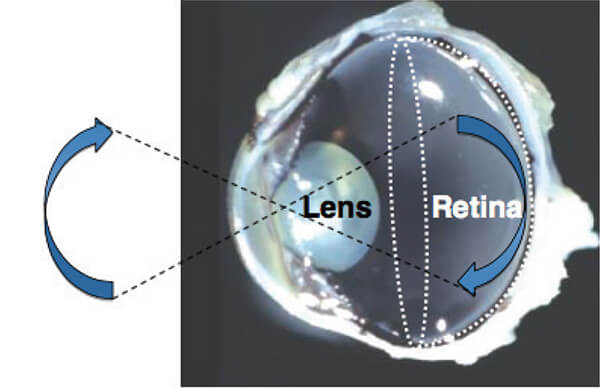
Figure 2. A sea turtle eye showing its lens which focuses the image on the retina (rear half of the eye surface, delineated by the dotted white lines). Notice that the image of the outside world (arrow) is inverted on the retina. That situation is corrected by the brain.
However, green turtles which spend the most time at shallow depths are the most uniformly sensitive to this entire spectrum. Loggerheads (feeding at intermediate depths) and leatherbacks (feeding at deeper depths) have eyes that are “tuned”, or especially sensitive, to a range of wavelengths centered around the light energies transmitted best to the depths where they live. That tuning, as one would predict, is most strongly expressed in the deepest diving species – the leatherback. Note, also, that all sea turtles are sensitive to light wavelengths than we can’t see, specifically UV light. We still do not understand how they use that capacity to their advantage.
Retinal Specialization: Visual “Streaks” and “Areas”
The vertebrate eye is sometimes called a “camera eye” since it possesses several similar components, specifically an iris opening (like an f-stop) that adjusts to different light levels, a lens that focuses the image, and a retina that (like a photosensitive screen) receives the image (Figure 2). But that’s where the similarities end! Notice that the image cast on the retina is upside down;
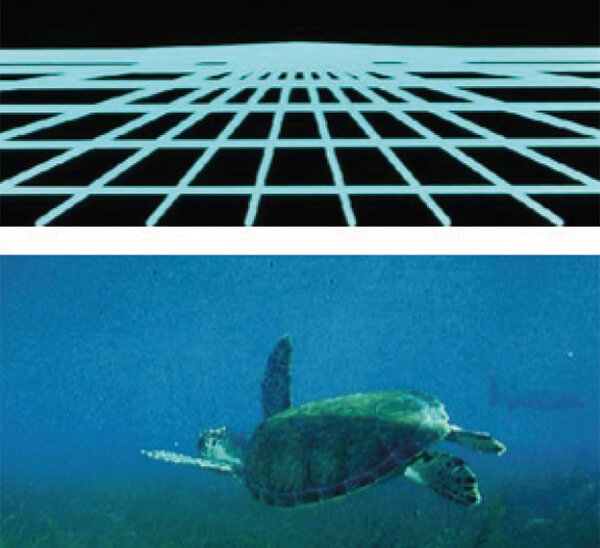
Figure 5. Animals that feed in open, unobstructed areas (top) have retinas with horizontal “streaks”. The green turtle, swimming in the seagrass meadow below, is an example.
the brain comes to the rescue by making our visual world right-side up. Another important difference between eyes and cameras is in how the image is analyzed. The retina, unlike a photosensitive screen, does not preserve the image as a point by point representation; rather, it consists of millions of cells organized in clusters (let’s call them “analyzers”) with specialized functions. Some analyzers respond to shapes or edges, some to colors and movement, still others to movement speed or movement direction, while others to a sudden decrease in light intensity (as might occur if a large predator, casting a shadow, approached from overhead). These analyzers, then, reflect biologically significant visual events and, at the same time, provide the brain with version of the outside world that is far more abstract than a picture.
One of our students took on the task of testing juvenile loggerheads to see if they had color vision (3). That task involved training the turtles to distinguish between three colored targets (blue, green and yellow) using a seawater-filled Y maze (Figure 8). The turtles had to swim toward a colored target at the end of an arm. A piece of shrimp was their reward for doing so but even though turtles love shrimp, learning that task took weeks. Several turtles never learned and flunked this class but six “high achiever” turtles graduated to the next level. Each of these turtles then had to learn to swim toward one target when simultaneously presented with a pair of colored targets, one of which had been previously rewarded. That took only a few days. Finally, and in the crucial test, each turtle had to choose the correct target from a pair when each target’s brightness varied from one trial to the next. All the turtles passed that test almost immediately, showing conclusively that targets were distinguished by their color. Bravo! Sea turtles have color vision!
Figure 7. A juvenile leatherback photographed as it dives down to attack a jellyfish located below and ahead in the water column.
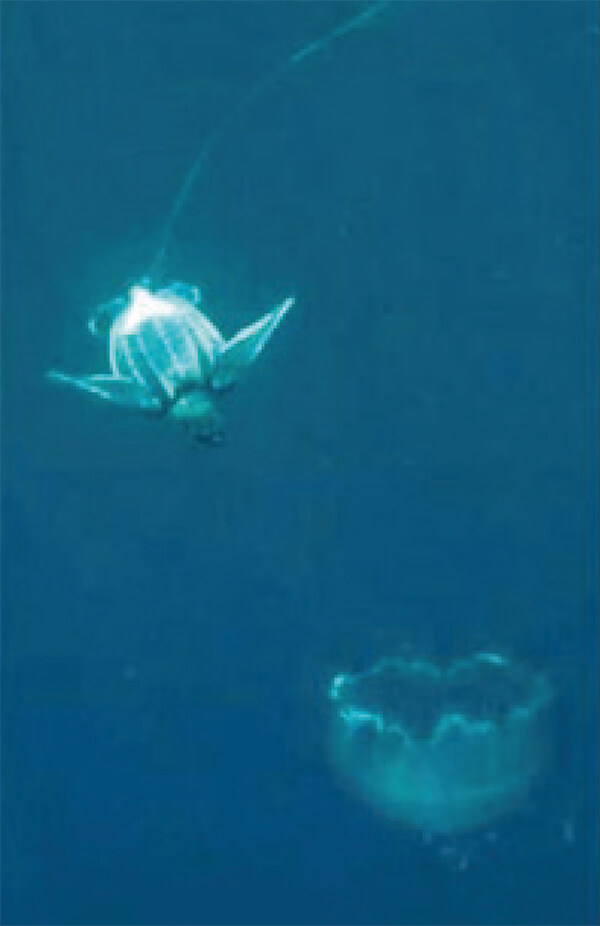
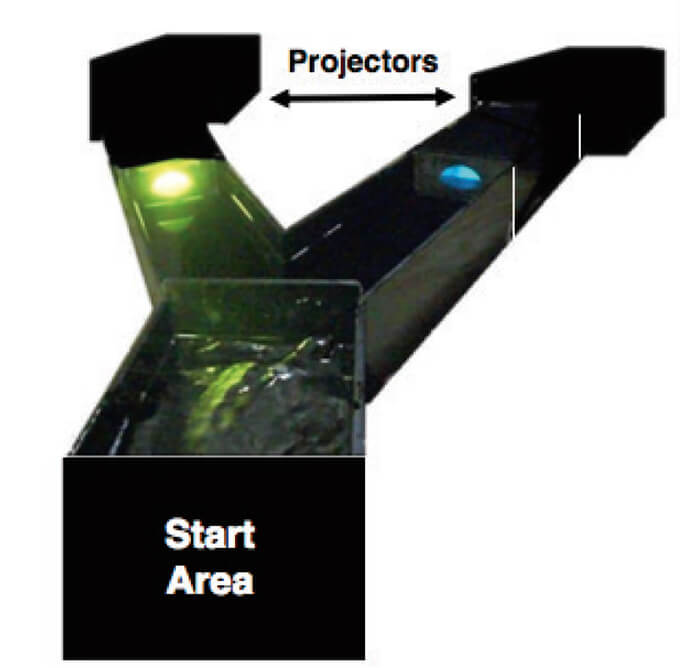
Figure 8. The water-filled Y-maze used to train loggerheads to swim toward colored targets (in this instance, one yellow and another blue) projected at the end of each arm. This turtle has learned to ignore the yellow target and approach the blue target. A well trained turtle, like this one, even points toward the blue target while confined to the maze start area.
Theses:Theses:
Judith Gocke (2011) Visual spectral sensitivity of loggerhead and leatherback hatchlings: a comparative study.
Lisa Oliver (2010) Retinal anatomy of hatchling sea turtles: anatomical specializations and behavioral correlates.
Morgan Young (2011) Visual wavelength discrimination by the loggerhead sea turtle.
Helping Sea Turtles Survive for 38 Years
A NON-PROFIT ORGANIZATION
State of Florida Registration Number CH-2841 | Internal Revenue Code 501 (c) (3)
Web Design & Development by Web Expressions, LLC

